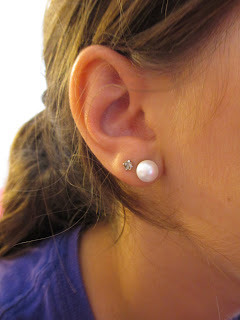Epithelial tissue-- This is one of my beautiful Nicaraguan babies I made friends with in June. Her name is Dayan, she is four years old, and I am in love with her sweet self. As every human is, she is covered head to toe in epithelial tissue, or in other words, "skin". Epithelial tissue is the lining of all internal and external parts of the body. The cells that make up this tissue are very closely packed together. Depending on the number of layers the tissue has, it can be divided into two types: simple (one layer) and stratified (two or more).
Population-- These are the two families of girls that I became the most close with in Nicaragua. I hung out with them, went to the store with them and they bought me candy, and I went to their house and hung out with their parents and watched Big Momma's House in spanish. Population is a group of people or species inhabiting one area. They interbreed and live in the same place at the same time. This is part of the Nicaraguan population that lives in Nicaragua, and in the village of El Chunco.
Genetic variation within a population-- I went dog sledding in Alaska. The dogs that pulled us were all Alaskan huskies. However, there was a genetic variation between coloring of the alaskan husky's fur. Some has a a typical husky look to them with the black and grey back and a white belly, while others were solid white. Ironically, it seemed as if the white huskies were behaved better than the others, but that is most likely just a coincidence. :)
Connective Tissue-- Connective tissue binds together other tissues. It has cells scattered unlike epithelial tissue. It attaches epithelial tissues to other tissues.There are many types of connective tissue: loose connective, fibrous, elastic, collagenous, and specialized connective tissues. An example of a specialized is cartilage, which is found in humans ears, nose, and trachea.
Glycogen-- Glycogen is how our body stores glucose. The liver produces it, while our muscle and fat cells store it. Eating carbohydrates is what forces more glycogen to be made, and it will be released when our blood glucose levels are low. Therefore, low carb diets hurt our glucose levels, by allowing it to not be stored because our body is not producing more glycogen to store it. South beach diet is a low carb diet. While some think it is a great weight loss diet, it actually is hurting your blood glucose levels.
Analogous Structures-- Analogous structures are structures of two or more different species that look similar and perform the same function but have evolved separately and at different times. The wings of birds and the wings of insects are an example of analogous structures.
Amniotic Egg-- Birds, mammals, and reptiles all lay amniotic eggs. They have yolks inside that nourish the organism that is developing inside the egg. The egg is used to protect the organism as it develops.







No comments:
Post a Comment